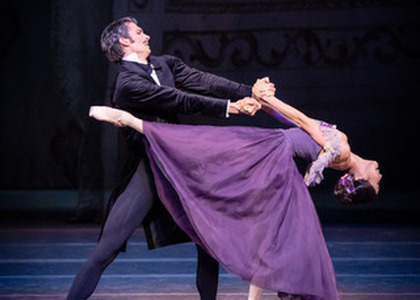> [Archived] Events

On the stage of the Vienna State Opera, the Onegin ballet represents an exemplary success
I had the impression that everything started from the famous painting of the German romantic Caspar David Friederich, The Wanderer above the Sea of Fog (1818). In the foreground, a young man is standing on a rocky peak, with its back to the viewer. He is dressed in a dark green overcoat and holds a walking stick in his right hand. With his hair tossed by the wind, the wanderer admires a landscape covered in a great foggy cloud. Several other ridges rise out of the mist, probably similar to the one he is standing on and on which clumps of trees can be seen. In the distance, on the left, you can spot mountains that pass gently into low plains. Beyond them, the glowing mist stretches endlessly, merging with the cloudy sky. That's how the Gaddis art historian John Lewis describes this picture in "The Landscape of History" (2002). We also see and recognize the figure of the Wanderer Friedrich, this time dressed in black, on Oneghin's first appearance on stage. A young man who turns his back on the world and gets lost into himself, into a selfish indifference, fueled by a huge ego. And, from here, all the misfortunes begin.
Pushkin's novel Eugene Onegin (1838) is well known, the work of the same title composed by Piotr Ilyich Tchaikovsky in 1879 is a masterpiece placed by the universal history of the opera theater in a place of great honor. It was, somehow, natural, for a choreographer to be attracted to the story and to create his own version on the given theme. His name was John Cranko, who signed both the choreography as well as the libretto. His ballet, Onegin, premiered in 1965 at the Stuttgart Opera. The public success keeps the literary work on the stages of all the great opera theaters in the world. Although Cranko admits that the idea came to him while working on the big ball scene in the opera (the famous Polish), the ballet's music contains nothing of Tchaikovsky's splendid score. The dancing is taking place on lesser-known pieces intended by the composer for the piano, orchestrated by Kurt-Heins Stolze so that it receives scope, grandeur, but also the melodic delicacy typical of the Russian composer's creation. And as quotes, we recognize only a few fragments from the overtures of Romeo and Juliet or Francesca da Rimini.
On the stage of the Vienna State Opera, the Onegin ballet is an exemplary success. The show seems torn from another world, a world of delicacy, of sincere and intense passions in which the characters float like in a dream full of color and fantasy. The "vintage" scenography and the costumes imagined by Elisabeth Dalton dresses the characters in a discreet polychromy where the folds of a dress or the float of a sleeve are carefully considered to enhance expressiveness. Cranko's choreography uses every detail of gesture, body movement or look to tell the story as clear, comprehensive and expressive as possible. And the dancers merge with their characters whose lives they live discreetly and yet full of force and expressiveness. The hard landmarks of the show are the two duets/dialogues/pas de deux in Acts I and III, in which the main characters are involved, Tatiana and Onegin. In the first moment, the choreographer imagined the letter that the young woman sent to her desired man as a dream in which the two meet and fall in love, sincerely and convincingly. The second moment marks the meeting of a Tatiana, a mature and married woman, with her greatest love from her youth, a once uncaring and cold onegin, now crushed by passion and by the revelation of an irreparable mistake.
Hyo-Jung Kang/Tatiana and Brendan Saye/Onegin make a perfect harmonious pair on stage. Technically speaking they were impeccable, expressively they were overwhelming, their dance outlines not so much facts and situations as deep feelings that the public understands and experiences, in turn, alongside the artists. Equally as valuable was the second couple of the story, Olga, Tatiana's sister/Aleksandra Liashenko and Lenski, Onegin's friend/Arne Vandervelde. The duel scene was performed ingeniously and spectacularly clever, a scene in which the shadow play is used. The Viennese Ballet Ensemble participates in this show in wonderful and colorful group moments. The Vienna State Opera under the baton of the conductor Robeert Reimer deeply contributes to the entire brilliance of the show.
Copyright: Wiener Staatsballett/Ashley Taylor
Translated by Ioana Negrea,
University of Bucharest, Faculty of Foreign Languages and Literatures, MTTLC, year II
Corrected by Silvia Petrescu














